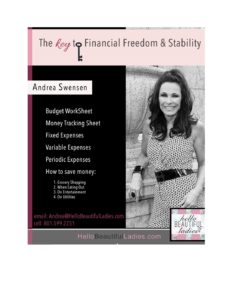ASK ANDREA – Investing In Your Future

Hello Beautiful Ladies. I recently had a blogger ask me about investing for retirement. If you check out the Free Money Management Guides and the IRAs & Self Directed Pensions Videos, Ebooks, & Workbooks on the www.HelloBeautifulLadies.com Website. you will find some excellent information to guide you through the process of investing and managing your money. Below are a few tips to get you started.
First – Please check out the FREE Money Making & Investment Guides, Videos, Ebooks and workbooks on our site to assist you with managing and investing your money. Don’t be afraid to“Take Charge” of your investments and retirement accounts. Check out the IRA & Self-Directed Pensions FREE downloadable information and guides on the www.HelloBeautifulLadies.com Website.
Disclaimer – HBL is providing information and suggestions, you will want to contact an investment professional before you make your decisions regarding investing and your retirement portfolio. I have my own self-directed IRA & Pension and have made more money than when I had my money in a 401K, Mutual Funds, and Stocks. If I can do it you can too. I was Afraid at first, however, now I am confident and secure in my decisions regarding my financial future and retirement.

Here are some additional tips on investing for retirement.
Investing is defined as “the outlay of money for income or profit.” The idea behind investing is to learn to put your money to work for you in something you believe will increase in value over time. Investing your money in the stock market may seem like a foreign concept; how do you know which funds to invest in? How does trading actually work? And what is a mutual fund? Should I invest in Real Estate, property, rental properties? Did you know that women tend to keep 10 percent more of their savings in cash than men? Women generally have a smaller total amount invested when they retire simply because we earn less. Keeping this in mind, it’s important to encourage women to become first-time investors. Instead of stashing money in your savings account, put it to work and invest, develop a portfolio, learn about real estate,
Okay so where do I start? That is where Hello Beautiful Ladies can help. Check out the IRA & Self-Directed Pensions documents available for FREE on our website.

Here is a guide for beginners:
- Investing builds wealth.
Is there anything more powerful than the idea of your money-making money for you, without you lifting a finger? That is the goal of investing. The power of compound interest means that the earlier you invest, the sooner your investments start growing and making money on your behalf. This builds your wealth far more rapidly than saving in a checking account. So, start investing when you are young. Don’t put it off and think that retirement is too far off in the future to worry about now. The average person needs at least 1 million dollars saved in order to retire.
- The market is where companies go to attract investors.
When people talk about investing in “the market,” what are they referring to? Today’s markets are largely exchanges — like the New York Stock Exchange (NYSE) — that allow us to buy and sell investments to others and NASDAQ, London Stock Exchange along with many others. The market is a general term for spaces where companies go to attract investors, and where investors buy and sell with each other.
- Investing allows you to own a portion of a larger business.
Buying stock is like purchasing a little slice of a company. Say you buy stock in consumer goods company P&G(manufacturer of Tide, Crest, Dawn, Tampax and many other household names); that stock costs $90.98 per share at the time of this writing. If you buy that share, you are betting that P&G will continue to grow and make money. P&G uses your $90.98 to invest in its business; open new locations, fund new products, hire new staff, etc. Buy low, sell high. If you choose to invest in the stocks & bonds market you must commit to watching the ups and downs weekly if not daily to know when the right time is to hold onto your investment and the right time to sell.
- Owners make money when the businesses they own make money.
Companies that offer stock to investors (like P&G) often give investors some of the money they earn. Every three months, these companies tell investors how they are doing by issuing financial statements. You need to review these financial statements and stay abreast of the changes in the market place. Set aside some time each night or morning to review the market. If they are doing well (taking in more money than they spend, which is called profit), they will often give a portion of the money to investors. These payments, called dividends, can be re-invested or cashed out by investors.
- You need an investment account to invest in the market.
Investment accounts are offered by financial services companies (like Vanguard, Charles Schwab and Fidelity) and allow you to buy stocks and other investments. Once you’ve determined what to invest in, it’s easier to select the right investment account. If you have your own Self-Directed IRA & Pension, which I highly suggest, then you can make your own decisions and you won’t have to pay these companies fees for managing and investing your money.
- Investment accounts come in several forms.
There are several types of investment accounts, designed for different purposes. Retirement accounts are for the future and include 401(k) and IRA accounts. These typically include penalties if you access them before retirement age, and the government often gives you tax breaks on them to encourage investing.
- 401(k) accounts are provided by employers & can help you save for retirement.
Retirement accounts, like a 401(k) or 403(b), can only be offered through your employer. They are named for the section of the Internal Revenue Code that outlines how they work. 401(k) plans can be offered by private companies. Similarly, 403(b) plans can be offered by public education employers, some non-profits and the like. I would suggest you put the maximum possible into your 401K and then maintain a separate IRA $ Self-Directed Pension.
- IRA accounts are for you to save for your retirement.
While 401(k) plans are offered by employers, a Roth or traditional IRA is available to anyone that earns an income. This helps those that work for companies that don’t provide a 401(k) benefit, as well as those who want to invest more for their retirement. There are many options to choose from and you can research the various companies that help you with your Self-Directed pensions and transactions. You will generally pay a one-time processing fee with these companies. Traditional IRAs are funded with wages that you have already paid taxes on.
- Certain IRA accounts (Roth IRAs) allow you to access money in the future, without taxes.
Roth accounts are funded with money that has already been taxed, so you do not owe the government any taxes when you access it in retirement. Some people prefer Roth accounts because they like the predictably of knowing they will not be taxed in the future. Regardless of whether you prefer a Roth or Traditional IRA, the most important step is to begin investing.
- You need to fund your investment account in order to buy investments.
Once you have selected both the type of account you are focused on (IRA, 401(k), brokerage) and the financial services provider you need to fund the account by putting money in. If you are just starting to invest, you can call the financial services provider or go to their website to send them your money and open your account. This money will sit in the investment account in cash until you decide which investments to purchase.
- It is difficult to select the right stock to buy.
All this knowledge is useless if you don’t put your money to work for you by selecting an investment. This is where many women, especially ones wanting to know all the details, can face analysis paralysis.
Since a stock is like purchasing a little slice of a company, many people like to analyze company information (financial performance, industry trends, competitive landscape, emerging regulations), and then buy the companies they think will win.
This can be difficult to do in the beginning. If you are buying individual stocks, it can be challenging to consistently make money.
- Mutual funds allow you to buy many companies in one purchase.
Mutual funds are one investment vehicle that allows us to buy many, many stocks in just one purchase. I like these because you can own hundreds of companies in each share. Many retirement accounts only allow mutual funds, given they offer more companies in each purchase and are generally seen as less risky than stocks.
- ETFs are like mutual funds, but cheaper.
ETFs area great form of investment. ETF stands for Exchange-Traded Fund. ETFs allow investors to buy many companies in a single share. They are nearly identical to mutual funds, except for some technical differences (how they are traded and regulated, for example).
These types of investments are generally less costly to the investor and have low expense ratios.
- Investments have costs.
What’s the expense ratio? This is how much the company that manages the mutual fund or ETF charges you for their work.
An average expense ratio is around .6% — meaning, for every $100 you have invested, the fund rakes in 60 cents. Sounds small — but tiny fees make a meaningful difference in your wealth over the long term. Average expense ratios can be .12% — meaning, for every $100 you invest in a mutual fund, they charge 12 cents.
Are there other fees? It can be costly to create fancy, actively-managed mutual funds. So, look carefully for purchase or redemption fees, or 12b-1 fees (marketing or distribution fees). You can find these fees easily online when you research your potential investments because companies are required to publish expense ratios and 12b-1 fees to their prospective investors. Fees are taken directly out of the investment, so you do not see a “line item” of how much they are when your money is invested. This is convenient for expensive funds with high fees. With Self Directed Pension, you pay a flat fee for each investment or transaction you make. You know the fee upfront so there are no surprises.
- Returns help investors compare performance.
Returns are indicators of how well (or poorly) investments perform. They help investors easily compare performance across different investment vehicles. Returns are expressed in percentages.For example, if I invested $100 in an ETF that achieved a four percent one-year return, I would have earned $4 in that time period.You can compare any range of time when looking at returns and compare your potential investment to a few big benchmarks.Investment returns are from past performance and are not a guarantee of how well they will do in the future. However, they are a useful indicator.
- Benchmarks like theS&P500 help compare performance.
How did this fund perform over the last decade, compared to the S&P 500? The S&P 500 is a very common performance benchmark because it includes the 500 largest U.S. companies. If the mutual fund or ETF seriously underperformed the S&P 500, it may not be worthy of your hard-earned money.
- Review the 10-year return to compare performance.
There are many ways to evaluate investment performance. I recommend using the 10-year return because I a longer view into performance provides you with more information.Compare your investments’ 10-year return to the S&P 500 10-year return so you can see if you are buying something slightly better than, or worse than, the performance of that group of companies.
- Target date funds can make investing for retirement easy.
Many financial services providers offer “target date funds” which are designed to help you save for retirement by adjusting over time. These funds buy less risky investments as the target date gets closer. If you are planning on retiring in 30 years, you would buy the target date fund that is dated 30 years from today. Be sure to keep an eye on the expense ratios and other fees associated with these funds.
- Investing is easier when you do it automatically.
I strongly recommend a regular, automatic transfer timed with your payday. Start with whatever you can afford today, and aim to steadily increase it over time. Automatic investing will ensure you’re always paying yourself first. Let’s take advice from Warren Buffett one more time. “Do not save what is left after spending, but spend what is left after saving.”

20 ) The best day to start investing is today.
Don’t hesitate to get started because of lack of knowledge or confidence. These basics will put you ahead of most who are hesitating to get started due to lack of knowledge or analysis paralysis. Don’t let that be you. Get started investing today.




